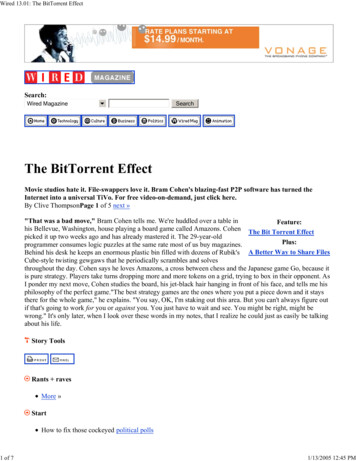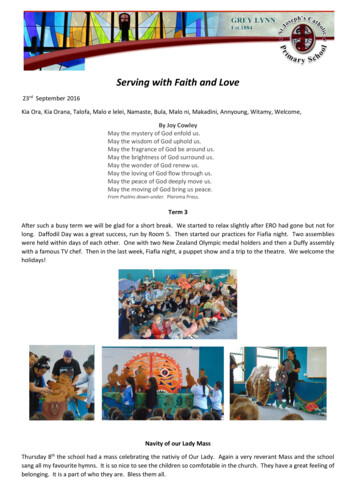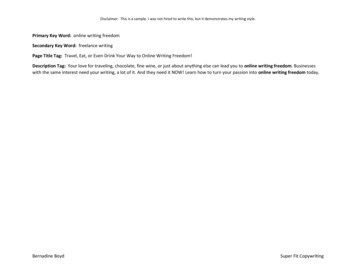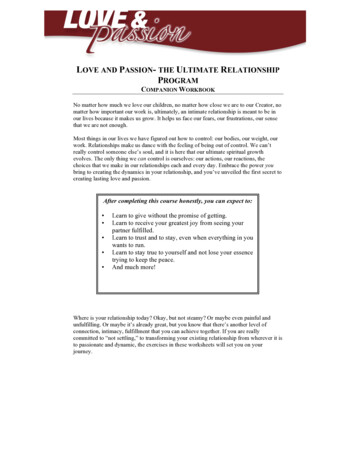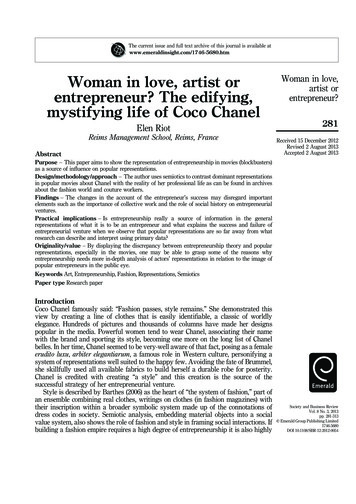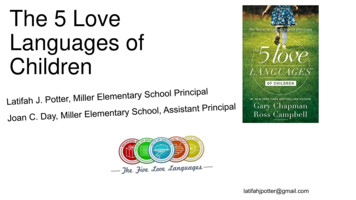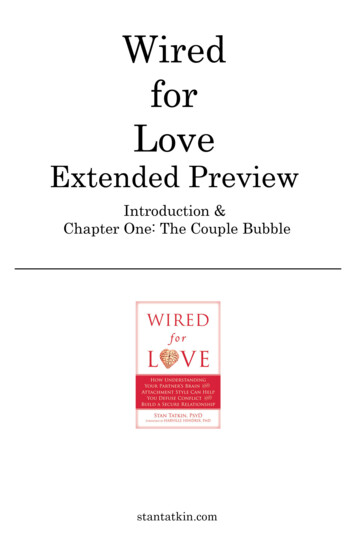
Transcription
Introduction: Wired for LoveLook around you. We live in a highly complex world. The array ofdevices, machinery, technology, and processes that make it tick ismindboggling. Just within the lifetime of many still alive today, humanity has come to regard as commonplace travel to the far side of the planet, theinstant replay of events around the globe, and the ability to speak to and seejust about anyone anywhere at any time, among many other things. We enjoythe advantages these scientific advances have brought us, and we curse themwhen they break down. And of course they do break down at times. For thisreason, we turn to guidebooks— everything from a car owner’s manual thatshows how much to inflate your tires, to the instructions that show how muchbatter to load in your waffle maker. We may hate the thought of consulting amanual (or calling for technical support, except perhaps in a pinch), but canyou really operate all these things successfully simply through intuition?Relationships are complex, too. Yet we often attempt them with a minimum of guidance and support. I’m not suggesting you should follow a standard set of 1- 2- 3 steps in relating to your partner. Relationships will nevercome with manuals that automate the process. We aren’t robots. What worksfor one couple won’t necessarily work for another. But neither does it work tofly blind, as many couples do, and expect relationships to fall into place.Hence the need for well- informed guidance that supports yourrelationship.And what might be considered well- informed in this context? In fact, alarge and fascinating body of scientific knowledge and theory with the potential to influence how partners relate to one another has been accruing inrecent decades. This includes revolutionary work in the fields of neuroscienceand neurobiology, psychophysiology, and psychology. I believe couples can
Wir ed for Lovebenefit from this wealth of research. You may find this idea intimidating, butdon’t worry: I’m not suggesting you need to quit your day job and go back toschool. I think you’ll find the basic theories quite straightforward when youhear them explained in lay language.In short, it’s my conviction that having a better understanding about howour brains function— in other words, how we’re wired— puts us in a betterposition to make well- informed choices in our relationships. Scientific evidence suggests that, from a biological standpoint, we humans have been wiredlargely for purposes that are more warlike than loving in nature. That’s thebad news. But the good news is that recent research suggests a variety of strategies and techniques are available to reverse this predisposition. We can, ineffect, take steps to assure we are primarily wired for love. These strategiescan help us create stable, loving relationships in which we are poised to effectively defuse conflict when it arises.So why not make use of them? In the first three chapters of this book, Iprovide you with general principles, drawn from cutting- edge research, tohelp you understand what makes a relationship successful and work towardthat with your partner. The chapters that follow expand on these principlesin practical ways. For example, if you have a clear sense of your partner’s relationship style based on the latest research, it will be easier for the two of youto work together and fix any problems that may arise. In essence, this bookcan serve as an owner’s manual for understanding yourself, your partner, andyour relationship.Now, you may raise your eyebrows at the notion of an owner’s manual.Your partner isn’t property, after all. I couldn’t agree more. However, I likethis metaphor because it conveys the level of mutual responsibility anddetailed knowledge of the relationship a couple needs to be successful. In fact,I would propose to you that all couples do in fact follow one or another set ofrules and principles in their relationship. They may not be conscious of it, butthey already have an owner’s manual of sorts. Unfortunately, many coupleshave the wrong manual. And in the case of distressed couples, they alwayshave it wrong.In my work with couples, I’ve noticed that partners tend to form theirown theories about the cause of their problems. They do this out of distressand despair, and out of their need to know why: “Why am I in pain?” “Whyam I feeling threatened or unsafe?” “Why is this relationship not working out2
Introductionas expected?” Partners work hard to come up with answers to such questions,and sometimes their answers provide an immediate sense of relief (“Now Iknow why this is happening”).However, in the long run, these theories generally don’t work. They aren’tsufficiently accurate to help the relationship. They don’t stop the pain. Theydon’t alter our fundamental wiring. Ultimately, relying on such theories is oneway of flying blind. In fact, at times, inaccurate theories further undermine acouple’s sense of security and happiness. More often than not, instead of ending the war between partners, grasping onto reasons and theories only createsmore of a fortress. It only supplies more ammunition for the couple to throwat one another.I’ve noticed partners’ theories almost always are pro- self, not pro- relationship. For instance, one partner says, “We argue because he doesn’tlike the same things I like.” Another says, “She’s so inconsiderate; no wonderI feel hurt.” Or “This relationship isn’t working because he’s not the person Imarried.” In each case, the focus is on the individual coming up with thetheory. One of the most important discoveries a couple can make is that it ispossible to shift into a pro- relationship stance. Theories from this stancesound more like the following: “We have problems sticking to our agreements,” or “We do things that hurt one another.” To make this shift, partnersmust be willing to throw out their old theories and consider new ones. Theymust be willing to rewire.Personally, I learned some of this the hard way.For many years, my specialty as a psychotherapist was working with individuals suffering from personality disorders. I became interested in the earlyprevention of such disorders. As my practice began to focus more on adultcouples, I found myself wanting to identify, earlier in the therapy, ways toprevent their problems, too.Around this time, one of the great shocks of my life came to pass. My firstwife and I divorced. During the period that followed, my need to understandwhy my marriage had failed led to a creative obsession, spurring me to moreclosely investigate the science behind relationships. I sensed that my fellowtherapists and I must be missing something, something more we could do tohelp couples in distress. And could do earlier in their relationship. I might nothave been able to salvage my marriage, but I could try harder to prevent failure for others and for myself in the future.3
Wir ed for LoveUltimately, I came up with several key areas of research I believed couldpoint toward the difference between success and failure in relationships. I’mnot speaking of research I conducted; these were the fields of study I mentioned earlier that have witnessed enormous leaps forward in the past fewdecades. The more I studied the latest findings and observed how they playedout daily in my office, the more lights flashed in my mind. I realized this valuable knowledge wasn’t being properly synthesized for and focused on adultcouples. Therapists working with couples had not begun to connect the disparate dots of various sciences. They were a bit like technical support peopleworking with out- of- date manuals. Their advice only went so far. I becameconvinced the most important thing I could do with my time and energy wasto find the connections between these areas of research and put them topractical clinical use.One of these areas is the field of neuroscience, the study of the humanbrain. This, I discovered, provides a physiological basis for understanding ourstrengths and weaknesses, including those that drive our relationships. Forexample, I am utterly stupid when it comes to math, an ability managed bymany parts of the brain, such as the intraparietal sulcus. Fortunately, my workdoesn’t depend on math, nor do my relationships with my wife and daughter.But my ability to read faces, emotional tone, and social cues (managed by thebrain’s right hemisphere) is a different matter. If I were weak in that area, Iwould be out of a job and maybe even a marriage (again). As we will see inchapter 2, some parts of our brain predispose us to first and foremost seeksecurity. This can wreak havoc on a relationship if we don’t learn to use themore evolved parts of the brain to override this wiring and exert control overthe primitive parts.A second area of research is attachment theory, which explains our biological need to attach to or bond with others, starting with our earliest relationships. Our early experiences form an instructional blueprint that is storedin body memory and becomes part of our basic relational wiring— our senseof safety and security. In a nutshell, some individuals are fundamentallysecure in their relationships, while others are insecure. Insecurity can lead usto remain distant from a partner or to harbor ambivalence about relating.However insecurity manifests, as we will see in chapter 3, it has insidiouseffects on a relationship if we don’t try to rewire the dysfunctional tendenciesacquired early in life.4
IntroductionThe third area of research I found fascinating and helpful was the biologyof human arousal. When you hear of arousal, you may immediately think ofsexual arousal. But I am referring here to a more general sense of arousal: ourmoment- to- moment ability to manage our energy, alertness, and readiness toengage. In the context of couples, research in this area suggests how we aspartners can manage one another’s highs and lows. We don’t have to remainat the mercy of each other’s runaway moods and feelings. Rather, as competent managers of our partners, we can become expert at moving, shifting,motivating, influencing, soothing, and inspiring one another.Each of these areas of research informs this book. In the past ten years, Ihave synthesized these ideas and integrated them into my therapy practice. Icall this work a psychobiological approach. Along the way, I realized thisapproach isn’t of value just to couples seeking therapy; everyone who is in oris planning to be in, or even hoping to be in, a relationship can benefit.And I have been a prime beneficiary. All the hard work I did paved theway for my current marriage, in which I discovered, and have for the first timebeen able to enjoy, a secure, functioning family. This relationship became thegold standard by which I could test and measure the principles described inthis book.As I mentioned, many couples seek reasons for their problems. Yet thetheories and reasons they come up with generally are false. The approach Iam offering can, I believe, make the difference. In a nutshell, I’ll help you harness the power of your brain and your partner’s brain for love instead of war,in a scientifically supported way. In this book, I present ten key principles thatshow you how to avoid common pitfalls that deter or undermine so manyrelationships. These principles are: Creating a couple bubble allows partners to keep each other safeand secure. Partners can make love and avoid war when the security- seekingparts of the brain are put at ease. Partners relate to one another primarily as anchors (securelyattached), islands (insecurely avoidant), or waves (insecurelyambivalent).5
Wir ed for Love Partners who are experts on one another know how to pleaseand soothe each other. Partners with busy lives should create and use bedtime andmorning rituals, as well as reunion rituals, to stay connected. Partners should serve as the primary go- to people for oneanother. Partners should prevent each other from being a third wheelwhen relating to outsiders. Partners who want to stay together must learn to fight well. Partners can rekindle their love at any time through eyecontact. Partners can minimize each other’s stress and optimize eachother’s health.These principles are based on the latest science, but let me stress again:you don’t have to grasp the technicalities of the science to understand theseprinciples. I have done that for you. In fact, I’ve done my best to make themfun and enjoyable. I promise not to put you to sleep with scientific jargon. AsI said, life is complex enough already. If there is a hallmark for this age, perhaps it will be our ability to take the complex findings of scientific researchand apply them smoothly and effectively in our everyday lives, to betterunderstand ourselves and to love more fully.Each chapter includes exercises to help you apply the principle discussedtherein. You can do most of the exercises on your own, or you and your partner can do them together. Actually, there is a certain irony here. An important premise of this book is that happy couples share a high degree of closenessand togetherness. Yet most people tend to read books— even books aboutrelationships— on their own. So I encourage you to buck this trend. Sharewhat is in this book with your partner. You will get even more out of it.6
Chapter 1The Couple Bubble:How You Can Keep EachOther Safe and SecureWho among us doesn’t want to feel loved? Finally to be able to beourselves just as we are, to feel cherished, cared for, andprotected— this has been the pursuit of humans since the beginning of recorded time. We are social animals. We depend on other people.We need other people.Some of us have parents or siblings or cousins or other family members togive us respite. Some of us turn to friends or colleagues. Some of us turn todrugs and alcohol or other substances or activities that make us feel alive,wanted, satisfied, relieved, or calmed. Some of us turn to personal growthseminars, or even seek psychological treatment. Some of us turn to our workor focus on hobbies. One way or another— through wholesome, healthymeans or less- than- savory means— we seek our safe zone.This longing for a safe zone is one reason we pair up. However, partners—whether in a romantic relationship or committed friendship—oftenfail to use each other as advocates and allies against all hostile forces. Theydon’t see the opportunities to make a home for one another; to create a safeplace in which to relax and feel accepted, wanted, protected, and cared for. Isee this frequently in couples who seek therapy. Often it is the very reasonthey seek professional help.
Wir ed for LoveThe Relationship Comes FirstJenny and Bradley were on the brink of break-up. Neither wanted to end therelationship, but bad things kept happening, and each blamed the other. Theyhad started dating as freshmen, and they were now about to graduate fromcollege. Both wanted to get married and have a family.Jenny’s family resided on the East Coast near the college. She enjoyedclose ties with them, particularly her mother, with whom she spoke daily.Bradley hailed from the West Coast, where his family lived. Because of thedistance, he made only one trip annually, each time inviting Jenny. She oftenfelt neglected during these trips, despite the fact that she adored Bradley’sfather. Bradley liked to attend parties and engage with his friends in a waythat left Jenny to fend alone against advances from other men and what sheconsidered dull conversations with their dates. Bradley never seemed tonotice Jenny’s discontent during these events, but certainly felt the sting ofher angry withdrawal afterward.Their conversations would go something like this:“You always do this!” she says. “You bring me to these things and thenleave me standing there as if I don’t exist. I don’t know why you bother toinvite me!”Bradley’s response is defensive. “I’m sick and tired of having this conversation. You’re being ridiculous. I didn’t do anything wrong!”To make her case, Jenny brings up Bradley’s friend, Tommy, who she sayshas been inappropriate with her. “He gets drunk and comes on to me, and youdon’t even notice. I don’t feel protected by you at all.”Bradley’s response, again, is dismissive. “He’s just playing around.”These conversations usually ended with Jenny going off to sulk andBradley feeling punished. Nor did things go better when the situation wasreversed. Jenny often visited her family, and expected Bradley to join her. Hecomplained she disappeared with her mother and sisters, forcing him to“hang” with her father, with whom he had little in common. When the couple were alone, their conversations about this sounded similar in many waysto the previous one:“I can’t stand coming here,” Bradley complains.“Why?” Jenny sounds surprised.8
The Couple Bubble“You keep sticking me with your father. I feel like a worm because hethinks I’m not good enough for you, and at dinner you act like you agree withhim!” Bradley’s voice rises in anger.“Shhh,” Jenny replies. “Don’t yell.”Bradley stops himself, pursing his lips and dropping his head. “I don’t getit,” he says in a lowered voice.“Get what?”“Why you invite me. I just feel bad here,” he says, without raising his headto look at her.Jenny softens and moves toward him with a loving gesture. “My familyloves you,” she says. “I hear that all the time from Mom and my sisters. Dadlikes you, too, he’s just like that.”Bradley’s face snaps into view, reddened, with tears in his eyes. “That’sbaloney! If your family ‘loves me,’” he says with finger quotations, “why don’tI hear it from them? If your dad is so loving, why don’t you sit with him, andlet me hang with your mom?”“Now you’re being ridiculous,” Jenny replies as she heads for the door.“Just forget it!”“And you know what else?” Bradley continues in hopes of her hearing.“You’re just like your dad. You put me down right in front of everyone.”Jenny leaves the room, slamming the door behind her.When we enter into a relationship, we want to matter to our partner, tobe visible and important. As in the case of Jenny and Bradley, we may notknow how to achieve this, but we want it so much that it shapes much of whatwe do and say to one another. We want to know our efforts are noticed andappreciated. We want to know our relationship is regarded as important byour partner and will not be relegated to second or third place because of acompeting person, task, or thing.It hasn’t always been this way. If we compare today’s love relationshipswith the relationships of old, we might be gravely disappointed. In centuriespast, rarely did couples get together simply because they loved one another.Marriages were arranged for political, religious, and economic purposes.Husbands and wives stayed together to provide security for their family. Atthe same time, duty and obligation— for both partners— served a male- advantaged social contract. Safety and security came at an emotional price.Yet no one complained, because nobody expected anything different.9
Wir ed for LoveIn our modern Western culture, marriage for love tends to be the norm.We expect to be swept off our feet or to feel whole and completed or to believewe’ve met our soul mate. And we expect this profound connection to sustainour relationship. Nothing seems more important. However, these feelings andideals often exact a price if we as partners are unable to provide one anotherwith a satisfying level of security. The truth is, even if a couple does experience a profound connection, this represents only the beginning of their relationship. What ultimately counts in the life of the couple is what happensafter their courtship, love affair, or infatuation phase. What counts is theirability to be there for one another, no matter what.Consider another couple, Greta and Bram, both thirty. When they married a year ago, they rented an apartment in the city, where Greta was securelyemployed as a school teacher. Bram’s family lived in a nearby rural town, andhe commuted to work in the family agricultural business.Each year, Greta was required to attend a gala fundraiser for her school.It was not the type of event that ordinarily suited Bram, who preferred dungarees to dress shirts, ties, and jackets. He also tended to feel shy and even abit tongue tied, especially in gatherings with folks he didn’t know. Greta, onthe other hand, moved well in large circles of strangers. Despite their differences, however, Bram prepared himself for an evening with Greta on his arm.Their conversation as they dressed went something like this:“It’s not you, you know,” Bram says with a concerned look on his face,while on his third attempt to make a proper tie. “I just don’t like being withall these people I don’t know.”“I know,” Greta replies, staring straight ahead as she applies her eyeliner.“I appreciate your willingness to come anyway. The moment you want toleave, we’ll go. Okay?”“Okay,” says Bram, as he finally gets the tie right.After she parks their car, Greta turns to Bram and switches on the overhead light. “How do I look?” she asks, puckering her lips.“Beautiful as usual,” Bram replies with a lingering gaze into her eyes.She scans his eyes in return, and a moment passes as they enjoy a mutualgale of excitement. “Let’s make a plan,” she says softly. “You’ll keep me onyour arm when we go in, and I’ll probably see some people I know. Don’t leaveme, okay? I want to introduce you.”10
The Couple Bubble“Okay,” Bram responds with an anxious smile. “What if I have to go tothe bathroom?” he quips.“You may go without me,” Greta quickly responds in kind, “but after that,I expect you to get your handsome butt back to your beautiful wife.”They share a smile and kiss. “This job is important,” Greta says as theyget out of the car, “but not as important as you are to me.”As you can see, Jenny and Bradley and Greta and Bram have very different ways of handling situations as a couple. It’s probably obvious which relationship works better, feels better, and deserves to be held up as exemplary.But let’s look at both couples in greater detail and see if we can understandwhy they function as they do, and how they came to be as they are.Autonomy versus MutualityImplicit in Jenny’s and Bradley’s narrative is a belief that each should standindependent of the other and should not expect to be looked after. We couldsay their model is one of autonomy. That is, they see themselves as individualsfirst, and as a couple second. When push comes to shove, they prioritize theirpersonal needs over their needs as a couple. If you questioned them aboutthis, they might reply that they value their independence, or that they are“their own person” and don’t let the other one boss them around.However, it’s not quite that simple. Yes, each expects the other to behavein an autonomous fashion, but in reality, this is the case only when it suits hisor her own purpose. When either finds that the proverbial shoe is now on theother foot, he or she feels dismissed, dropped, and unimportant. This couple’ssense of independence works especially poorly in situations in which theydepend on one another to feel important and protected. They are unaware ofthis problem when they think they’re maintaining their so- called autonomy,but painfully aware when they feel they are the victim of neglect.I think it’s fair to say the autonomy implied by Jenny’s and Bradley’sbehavior is not really autonomy at all. Rather, they are living according to an“If it’s good for me, you should be all right with it” type of agreement. As aresult, they continually play out situations wherein they each fail to rememberthe other person. Their underlying message is “You do your thing and I’ll do11
Wir ed for Lovemy thing.” Sounds mutual, doesn’t it? Yet it is anything but mutual because itrequires that the other partner be okay or else, and it condones the partnersreadily throwing one another under the bus. This brand of autonomy doesn’treflect true independence, but rather a fear of dependency. Instead of representing strength, it can represent weakness.In contrast, Bram and Greta each appear to know something about howthe other thinks and feels, and each cares about that. We can say their modelis one of mutuality. It is based on sharing and mutual respect. Neither expectsthe other to be different from who he or she is, and both use this sharedknowledge as a way to protect one another in private as well as public settings.For example, Greta anticipates Bram’s discomfort and addresses it in a waythat protects his dignity. She acts as if she needs him, though she knows he isthe needier one in this situation. Neither Bram nor Greta is poised to throwthe other under the bus. It is as if they maintain a protective bubble aroundthemselves.The couple bubble is a term I like to use to describe the mutually constructed membrane, cocoon, or womb that holds a couple together and protects each partner from outside elements. A couple bubble is an intimateenvironment that the partners create and sustain together and that implicitlyguarantees such things as: “I will never leave you.” “I will never frighten you purposely.” “When you are in distress, I will relieve you, even if I’m the onewho is causing the distress.” “Our relationship is more important than my need to be right,your performance, your appearance, what other people think orwant, or any other competing value.” “You will be the first to hear about anything and not the second,third, or fourth person I tell.”I say “implicitly,” but couples can and often do make explicit agreementsaround any or all of the elements that constitute the couple bubble.12
The Couple BubbleExercise: How Close Are You?The feeling of closeness is subjective; that is, how close you feel to your partner and how safe you feel both take place within you. You may feel very closeto your partner, but he or she isn’t likely to know how you feel unless you sayso. And the same goes for how your partner feels about you.Now, discover some of the ways you offer closeness to your partner.1. In the previous section, I listed some guarantees couples give oneanother—for example, saying, “I will never leave you.” What such guarantees have you given to your partner?2. What guarantees would you like to give?3. What guarantees would you like to receive?4. You don’t need to receive a guarantee from your partner before you offerone. Look for moments when you can express your feelings of closenessand promise safety.How Couples Come to ValueAutonomy Over MutualityAlongside our modern Western emphasis on autonomy, we see increasingevidence of loneliness inside and outside of marriages; a rising incidence ofviolence and alienation; and divorce rates that, while they may be decreasing,remain well above ideal. Like Jenny and Bradley, couples in distress too oftenturn to solutions that can be summed up by “You do your thing and I’ll do mything” or “You take care of yourself and I’ll take care of myself.” We hear poppsychology pronouncements such as “I’m not ready to be in a relationship”and “You have to love yourself before anyone can love you.”Is any of this true? Is it really possible to love yourself before someone everloves you?13
Wir ed for LoveThink about it. How could this be true? If it were true, babies wouldcome into this world already self- loving or self- hating. And we know theydon’t. In fact, human beings don’t start by thinking anything about themselves, good or bad. We learn to love ourselves precisely because we have experienced being loved by someone. We learn to take care of ourselves becausesomebody has taken care of us. Our self- worth and self- esteem also developbecause of other people.If you don’t agree with what I’m suggesting, check it out for yourself.Think of a time when you were young and your parents didn’t believe in youin some way. Were you still able to believe in yourself? Maybe you were. But ifso, how did you do it? From where or from whom did you get your belief? Orthink of an ex–romantic partner who didn’t believe in you or trust you. Wereyou able to believe in or trust yourself nonetheless? From where did you getthat belief and trust? In each of these cases, chances are very good that if youdid believe in yourself, that belief originated with somebody important to you.This is how we come to be as we are: all our prior interactions and relationships have shaped the person we are today.Many couples who come together these days share various ideals aboutlove relationships, yet their prior experiences of love don’t match up with theirideals. That’s a problem, because nitty- gritty personal history always trumpsideals. This is just the way we’re wired. If, for example, we didn’t witness devotion in our parents’ marriage, we won’t have positive role models for loving todraw upon in our own adult relationships. If we never saw mutual care, sensitivity, and repair in our parents’ marriage, those values likely will elude us.Our two couples clearly illustrate this principle. Neither Bradley norJenny is doing anything radically different from what he or she experienced asa child. For instance, Jenny’s mother often abandoned Jenny’s father in socialsituations, just as Jenny now abandons Bradley. Jenny never experienced herparents as loving or close. To the contrary, they often used the children intheir arguments. Jenny’s mother complained to her father about his going offto be with his pals at the bar and leaving her to fend for herself. Bradley’sparents often were too busy doing their own thing to spend much time withtheir kids. His mother was known to drive his father out of the house with hercriticism, something Bradley also resents whenever he becomes Jenny’s targetof harsh judgment.14
The Couple BubbleNeither Bram nor Greta consider their parents perfect, but both felt aschildren that their parents loved and respected one another. Both have childhood memories o
Introduction: Wired for Love L ook around you. We live in a highly complex world. The array of devices, machinery, technology, and processes that make it tick is mindboggling. Just within the lifetime of many still alive today, human - ity has come to regard



